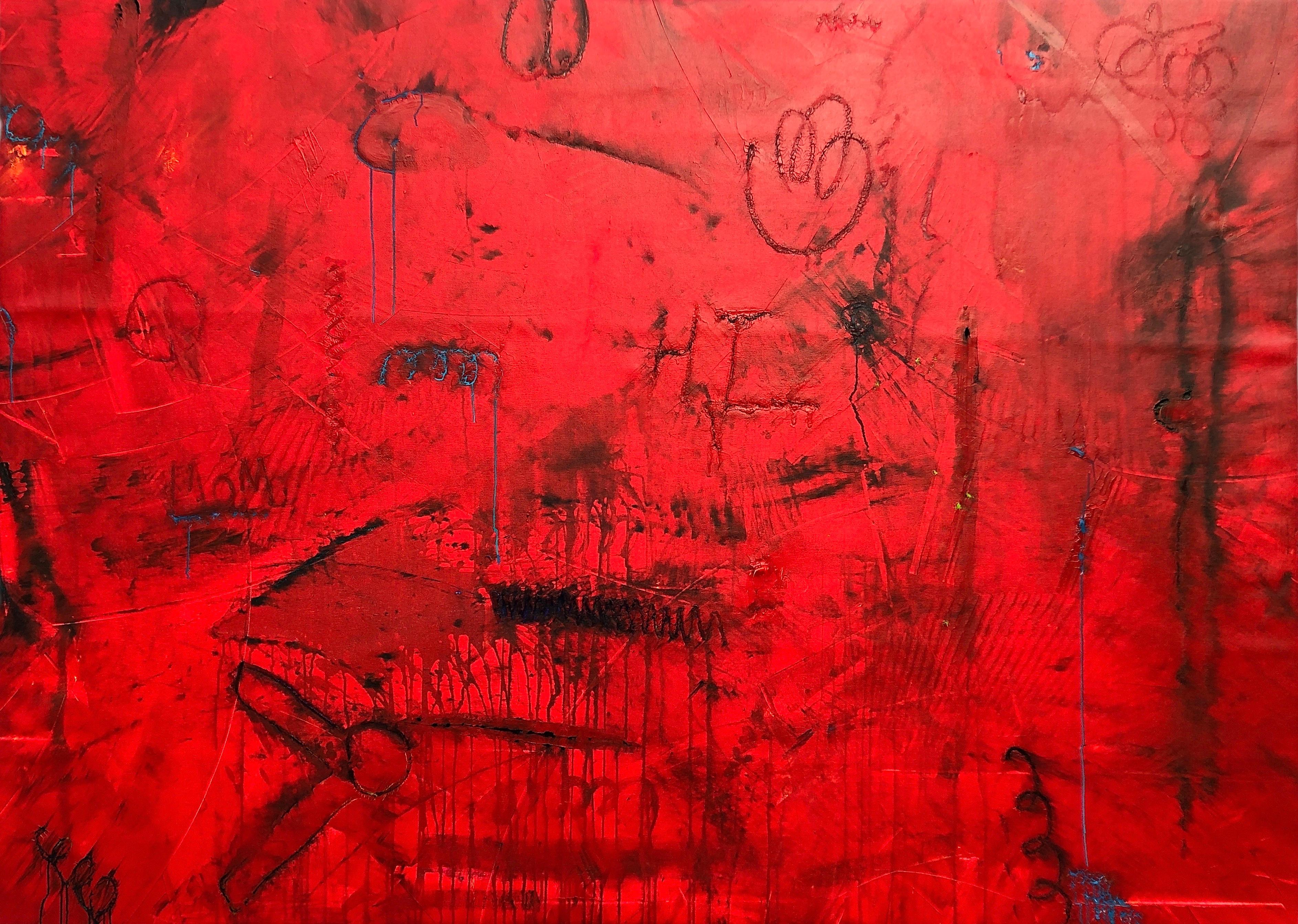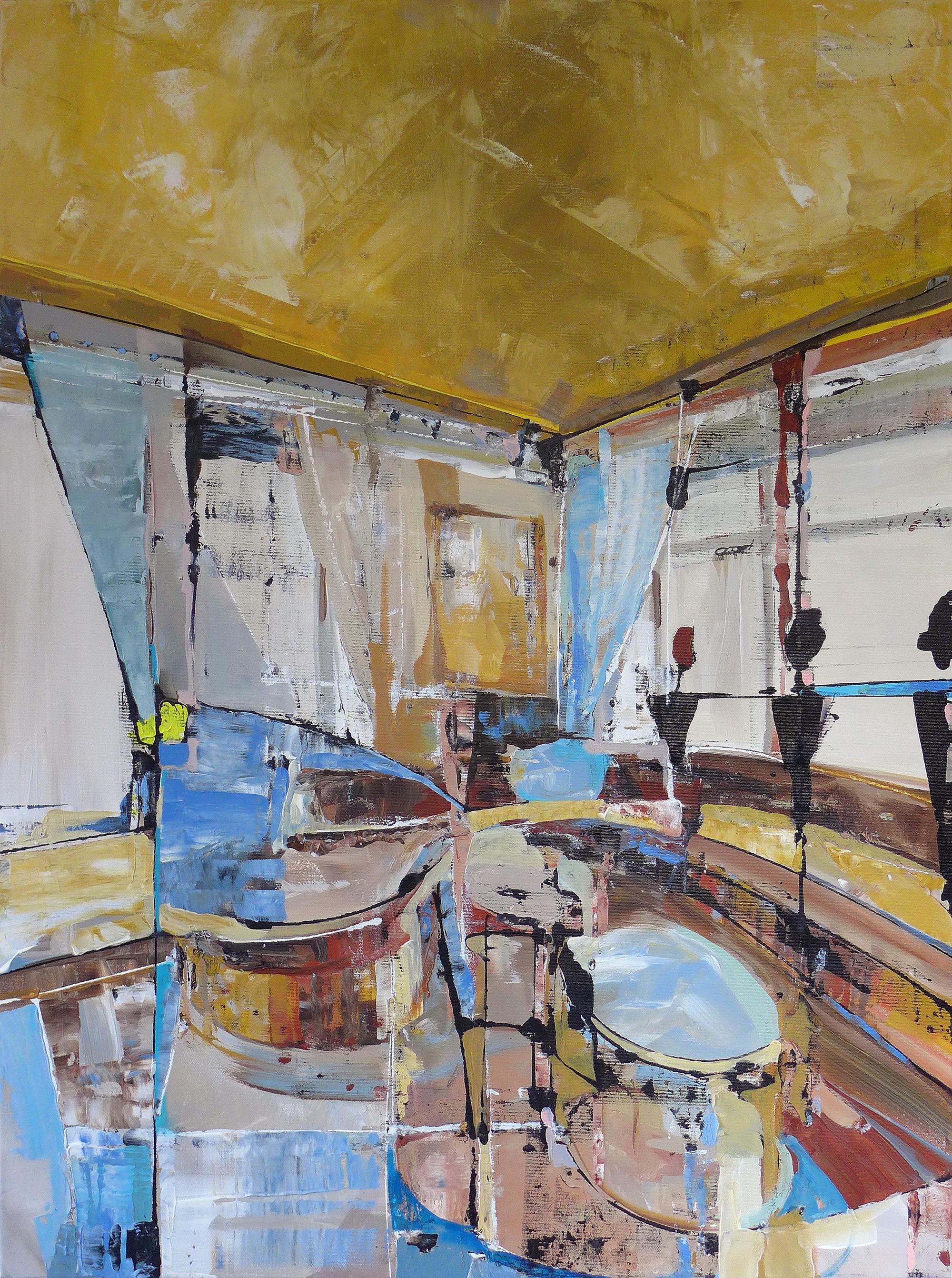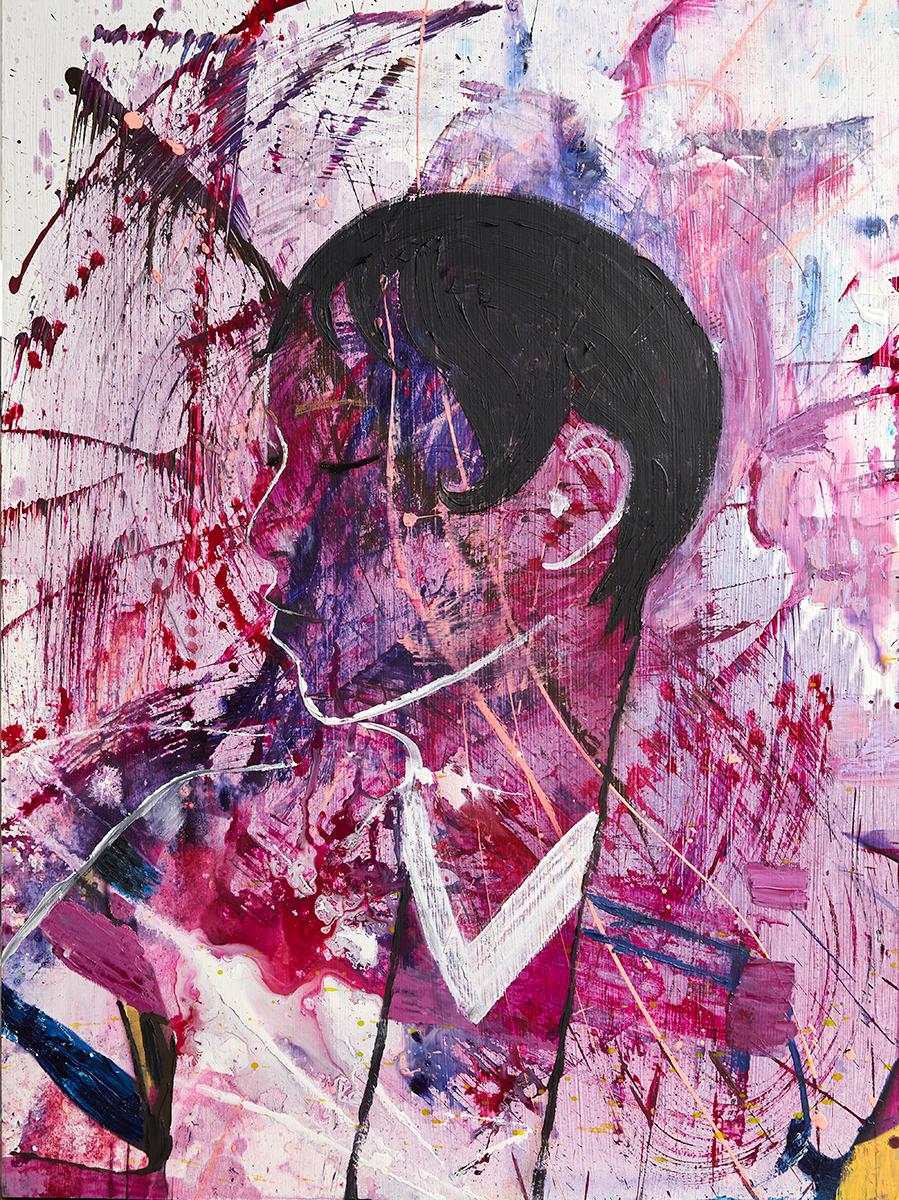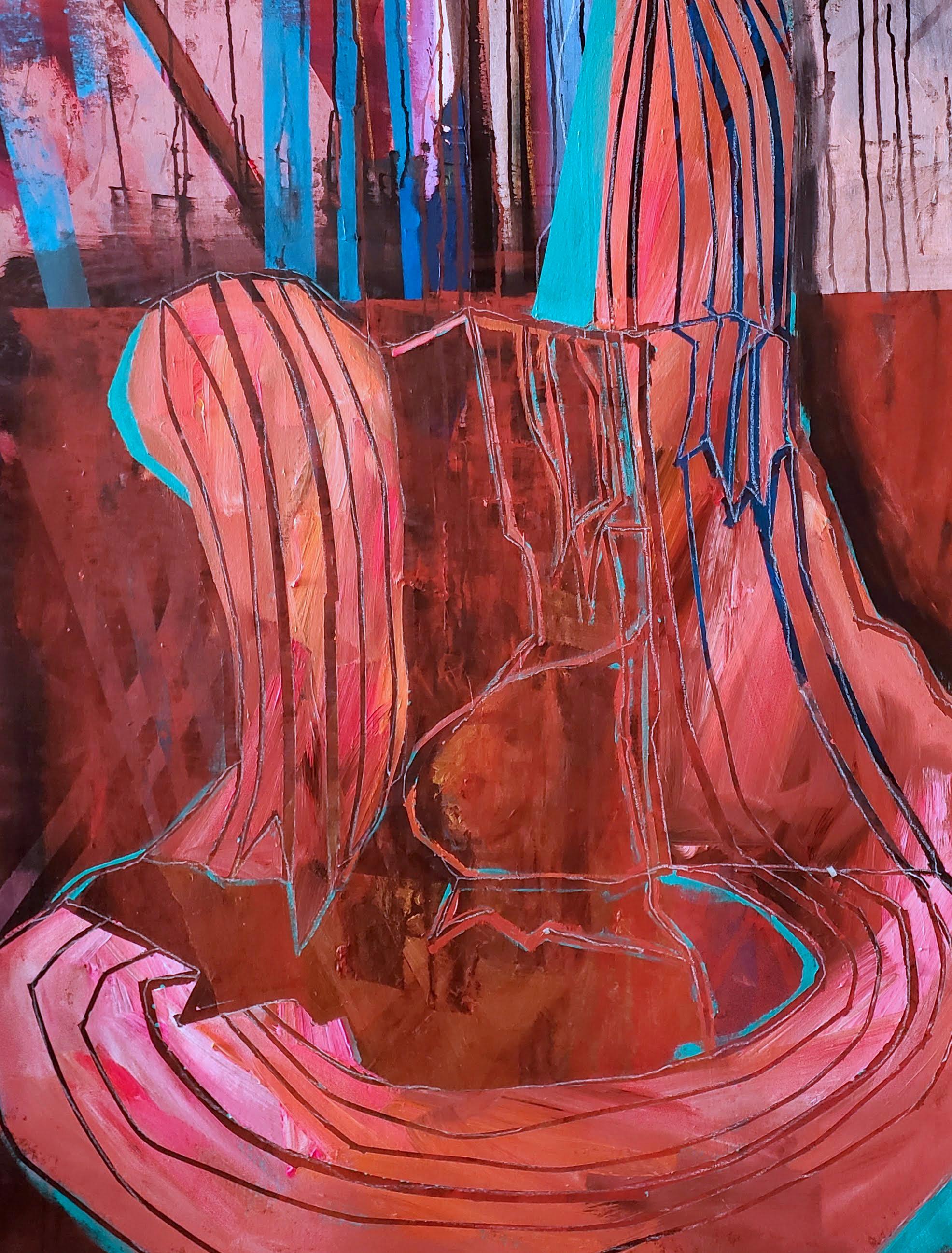Items Similar to Panama Garden, Mid-century abstract expressionist modern work
Want more images or videos?
Request additional images or videos from the seller
1 of 7
Richard AndresPanama Garden, Mid-century abstract expressionist modern workc. 1964
c. 1964
About the Item
Richard Andres (American, 1927-2013)
Panama Garden, c. 1964
acrylic on canvas
signed lower right, signed and titled verso
46 x 38 inches
Richard Andres was born in Buffalo, New York in 1927. A graduate of the Cleveland Institute of Art in 1950, he was immediately drafted and served for two years in the army as a mural painter. He received his Master of Arts from Kent State in 1961. A frequent exhibitor at galleries and museums and winner of multiple May Show prizes, Andres taught art in the Cleveland Public Schools for 28 years, as well as teaching the University of Buffalo, the Cleveland Institute of Art and the Western Reserve University.
Very little in Richard Andres’ childhood would have predicted his love of classical music, mid-century-modern architecture and certainly not his lifelong passion for art and in particular abstract art. Richard’s father, Raymond, had no more than a third-grade education, and his mother, Clara, was one of thirteen children – only three of whom lived into adulthood and none of whom attended high school.
They lived, when Richard was a boy, in a dingy area of Buffalo, NY in a walk-up apartment situated above a tavern. Raymond and Clara supplemented the income from their factory jobs in the bar downstairs with Raymond playing ragtime on the piano and Clara serving drinks. This often left Richard and his two older brothers at home alone to fend for themselves. The two older boys, Raymond and Russell, were - unlike Richard- rather rough and tumble and entertained themselves with stickball, boxing and the like. Richard, on the other hand, from a very young age liked to draw, or better yet even, to paint with the small set of watercolors he received for Christmas one year. Paper, however, at the height of the depression, was hard to come by. Luckily, Clara used paper doilies as decoration for the apartment and Richard would contentedly paint and then cut up doilies, gluing the pieces together to create collages.
At eight-years-old, he discovered the Albright-Knox Museum (then known as the Albright Art Gallery) and spent several hours a week there studying the paintings. He was particularly fond of Charles Burchfield‘s landscapes, enamored with their ‘messiness’ and thinking that they somehow captured more ‘feeling’ than works he was previously familiar with. For his tenth Christmas, he asked for and received a ‘how-to’ paint book by Elliot O’Hare. Through this self-teaching, he assembled the portfolio needed for acceptance to Buffalo Technical High School where he studied Advertising Arts. In his Junior year, he was encouraged to enter a watercolor painting, “Two Barns,” in the national 1944-45 Ingersoll Art Award Contest and was one of twelve grand prize winners – each one winning one hundred dollars. More importantly the painting was exhibited at the Carnegie Institute Galleries, which resulted in his winning a national scholarship to the Cleveland School of Art (The Cleveland Art Institute).
He flourished at the art school under the tutelage of faculty members such as Carl Gaertner, as well as that of visiting artists such as William Sommer and Henry George Keller. He would say in later years that Gaertner, in particular, influenced his attitude toward life as well as art. “Gaertner,” Andres said, “believed that there was no need to be a ‘tortured artist’, that an artist should rather enjoy beauty, family, and life in general.” Free to spend his days as he chose, he wandered the Cleveland Art Museum for most of the hours he was not attending classes or painting; the remaining time was spent drinking coffee at a local hangout with art school friends – which is where he met fellow Henry Keller scholarship winner, Avis Johnson. Richard was immediately smitten with Avis, but being rather shy, it took him the entire summer of 1948 to build up his courage to ask her out. Over that summer he ‘thought about Avis’ and worked in a diner to save money. He also used the hundred-dollar prize money won in High School to visit the first Max Beckmann retrospective in the United States at the City Art Museum in St. Louis. Over a half century later he spoke of that exhibit with a reverence usually reserved for spiritual matters, “I walked in and it was like nothing I had ever seen before... the color...It just glowed.”
Returning to campus in the Fall, the first thing he did was go to the coffee shop in hopes of finding Avis. He did, and she, upon seeing him, realized that she was also smitten with him. They quickly became known as ‘the couple’ on campus, and a year later, with Richard being drafted for the Korean war, they were quickly married by a Justice of the Peace, celebrating after with family at Avis’s Cleveland home. As a gift, faculty member John Paul Miller designed and made the simple gold wedding ring Avis wore for their 65 years of marriage. During those 65 years neither wavered in their mutual love, nor in the respect they shared for one another’s art.
The couple lived in a converted chicken coop in Missouri while Richard was in boot camp. At the camp, he would volunteer for any job offered and one of those jobs ended up being painting road signs. His commander noticed how quickly and neatly he worked and gave him more painting work to do - eventually recommending him for a position painting murals for Army offices in Panama. Until her dying day, Avis remained angry that “The army got to keep those fabulous murals and they probably didn’t even know how wonderful they were.” In Panama, their first son, Mark, was born. After Richard’s discharge in 1953, they moved back to the Cleveland area and used the GI bill to attend Kent State gaining his BA in education. The small family then moved briefly to Buffalo, where Richard taught at the Albright Art School and the University of Buffalo – and their second son, Peter, was born. Richard had exhibited work in the Cleveland May Show and the Butler Art Museum during his art school years, and during the years in Buffalo, his work was exhibited at the gallery he had so loved as a child, the Albright Art Gallery.
In 1956, the family moved back to the Cleveland area and Richard began teaching art at Lincoln West High School during the day while working toward his MA in art at Kent State in the evenings. Avis and Richard, with the help of an architect, designed their first home - a saltbox style house in Hudson, Ohio, and in 1958, their third son, Max (after Max Beckmann) was born. Richard enjoyed the consistency of teaching high school as well as the time it gave him to paint on the weekends and during the summer months. In 1961, he received his MA and his daughter, Claire, was born. With a fourth child, the house was much too small, and Avis and Richard began designing their second home. An admirer of MCM architecture, Richard’s favorite example of the style was the Farnsworth house – he often spoke of how the concepts behind this architectural style, particularly that of Mies van der Rohe, influenced his painting.
Andres described himself as a 1950’s painter, not fully accepting the designation of ‘Abstract Expressionist’ or ‘Abstract’ he saw his work as an extension of those styles, but rooted in the wider mid-century architectural concept of immersing the individual with nature, and the breakdown of the barrier between interior and exterior spaces. The house Avis and Richard built in 1967, with its open concept, and large glass curtainless windows reflected that concept, and the influence of living in that type of space can be seen in his later works. As Avis liked to say, “The idea is to have the walls be glass, but you need some real walls to have somewhere to hang paintings.”
In this house, Richard developed a style of painting that harkened back to his early years. In his studio, a room in the house with a large window, he would roll out large thin paper - the type used for architectural blueprints on the floor and paint on it. The large rolls of paintings would then be cut into pieces and then glued onto canvas, creating that ‘glow’ of color he admired in Beckmann’s exhibit. These paintings, often with titles such as “Windows” or “Gardens” have transparency that reflects the breaking of interior/exterior boundaries of mid-century architecture as well as a joy realized in those early words of Carl Gaertner. In his late life Andres was fond of saying, “I am the wealthiest man in the world, look around, I have everything anybody could want. Look at my wife, my house, and all this art.”
- Creator:Richard Andres (1927 - 2013, American)
- Creation Year:c. 1964
- Dimensions:Height: 46 in (116.84 cm)Width: 38 in (96.52 cm)
- Medium:
- Movement & Style:
- Period:
- Condition:
- Gallery Location:Beachwood, OH
- Reference Number:1stDibs: LU1768211712602
About the Seller
No Reviews Yet
Vetted Seller
These experienced sellers undergo a comprehensive evaluation by our team of in-house experts.
Established in 1975
1stDibs seller since 2022
9 sales on 1stDibs
Typical response time: 10 hours
- ShippingRetrieving quote...Ships From: Beachwood, OH
- Return PolicyA return for this item may be initiated within 14 days of delivery.
More From This SellerView All
- Interior, large, colorful figural abstract red, orange, blue acrylic of coupleBy Richard AndresLocated in Beachwood, OHRichard Andres (American, 1927-2013) Interior, 1976 acrylic on canvas signed lower right, signed and titled verso 50 x 59.5 inches Richard Andres was born in Buffalo, New York in 1927. A graduate of the Cleveland Institute of Art in 1950, he was immediately drafted and served for two years in the army as a mural painter. He received his Master of Arts from Kent State in 1961. A frequent exhibitor at galleries and museums and winner of multiple May Show prizes, Andres taught art in the Cleveland Public Schools for 28 years, as well as teaching the University of Buffalo, the Cleveland Institute of Art and the Western Reserve University. Very little in Richard Andres’ childhood would have predicted his love of classical music, mid-century-modern architecture and certainly not his lifelong passion for art and in particular abstract art. Richard’s father, Raymond, had no more than a third-grade education, and his mother, Clara, was one of thirteen children – only three of whom lived into adulthood and none of whom attended high school. They lived, when Richard was a boy, in a dingy area of Buffalo, NY in a walk-up apartment situated above a tavern. Raymond and Clara supplemented the income from their factory jobs in the bar downstairs with Raymond playing ragtime on the piano and Clara serving drinks. This often left Richard and his two older brothers at home alone to fend for themselves. The two older boys, Raymond and Russell, were - unlike Richard- rather rough and tumble and entertained themselves with stickball, boxing and the like. Richard, on the other hand, from a very young age liked to draw, or better yet even, to paint with the small set of watercolors he received for Christmas one year. Paper, however, at the height of the depression, was hard to come by. Luckily, Clara used paper doilies as decoration for the apartment and Richard would contentedly paint and then cut up doilies, gluing the pieces together to create collages. At eight-years-old, he discovered the Albright-Knox Museum (then known as the Albright Art Gallery) and spent several hours a week there studying the paintings. He was particularly fond of Charles Burchfield‘s landscapes, enamored with their ‘messiness’ and thinking that they somehow captured more ‘feeling’ than works he was previously familiar with. For his tenth Christmas, he asked for and received a ‘how-to’ paint book by Elliot O’Hare. Through this self-teaching, he assembled the portfolio needed for acceptance to Buffalo Technical High School where he studied Advertising Arts. In his Junior year, he was encouraged to enter a watercolor painting, “Two Barns,” in the national 1944-45 Ingersoll Art Award Contest and was one of twelve grand prize winners – each one winning one hundred dollars. More importantly the painting was exhibited at the Carnegie Institute Galleries, which resulted in his winning a national scholarship to the Cleveland School of Art (The Cleveland Art Institute). He flourished at the art school under the tutelage of faculty members such as Carl Gaertner, as well as that of visiting artists such as William Sommer and Henry George Keller. He would say in later years that Gaertner, in particular, influenced his attitude toward life as well as art. “Gaertner,” Andres said, “believed that there was no need to be a ‘tortured artist’, that an artist should rather enjoy beauty, family, and life in general.” Free to spend his days as he chose, he wandered the Cleveland Art Museum for most of the hours he was not attending classes or painting; the remaining time was spent drinking coffee at a local hangout with art school friends – which is where he met fellow Henry Keller scholarship winner, Avis Johnson. Richard was immediately smitten with Avis, but being rather shy, it took him the entire summer of 1948 to build up his courage to ask her out. Over that summer he ‘thought about Avis’ and worked in a diner to save money. He also used the hundred-dollar prize money won in High School to visit the first Max Beckmann retrospective in the United States at the City Art Museum in St. Louis. Over a half century later he spoke of that exhibit with a reverence usually reserved for spiritual matters, “I walked in and it was like nothing I had ever seen before... the color...It just glowed.” Returning to campus in the Fall, the first thing he did was go to the coffee shop in hopes of finding Avis. He did, and she, upon seeing him, realized that she was also smitten with him. They quickly became known as ‘the couple’ on campus, and a year later, with Richard being drafted for the Korean war, they were quickly married by a Justice of the Peace, celebrating after with family at Avis’s Cleveland home. As a gift, faculty member John Paul Miller...Category
1970s Abstract Expressionist Abstract Paintings
MaterialsAcrylic
- Untitled abstract expressionist oil painting by Cleveland School artistBy Richard AndresLocated in Beachwood, OHRichard Andres American, 1927-2013 Untitled, c. 1984 acrylic and ink on paper mounted on canvas signed lower right 19 x 16 inches Richard Andres was born in Buffalo, New York in 192...Category
1980s Abstract Expressionist Abstract Paintings
MaterialsInk, Acrylic
- Reflections, large abstract expressionist painting by Cleveland School artistBy Richard AndresLocated in Beachwood, OHRichard Andres American, 1927-2013 Reflections, 1985 acrylic and ink on paper mounted on canvas signed lower right, signed, dated and titled verso 52.5 x 72.5 inches 53 x 73 inches, ...Category
1980s Abstract Expressionist Abstract Paintings
MaterialsInk, Acrylic
- Untitled abstract expressionist oil painting by Cleveland School artistBy Richard AndresLocated in Beachwood, OHRichard Andres American, 1927-2013 acrylic and ink on paper mounted on canvas 12 x 10 inches Richard Andres was born in Buffalo, New York in 1927. A graduate of the Cleveland Instit...Category
1980s Abstract Expressionist Abstract Paintings
MaterialsInk, Acrylic
- The King, abstract expressionist painting by Cleveland School artistBy Richard AndresLocated in Beachwood, OHRichard Andres American, 1927-2013 The King of Diamonds Accepts Challenges, 1982 acrylic and ink on paper mounted on canvas signed lower right, signed and titled verso 47.5 x 47.5 in...Category
1980s Abstract Expressionist Abstract Paintings
MaterialsInk, Acrylic
- Untitled abstract expressionist oil painting by Cleveland School artistBy Richard AndresLocated in Beachwood, OHRichard Andres American, 1927-2013 Untitled, c. 1980 acrylic and ink on paper mounted on canvas signed lower right 24 x 20 inches 25 x 21 inches, framed Richard Andres was born in B...Category
1980s Abstract Expressionist Abstract Paintings
MaterialsInk, Acrylic
You May Also Like
- Contemporary Red Painting Primitive Power By Troy SmithBy Troy Smith StudioLocated in Toronto, CAHidden words and symbols hide beneath the bold red exterior of the painting. Solid watercolours were used to sketch shapes below the surface. The red surface treatment reacted with t...Category
21st Century and Contemporary Abstract Expressionist Abstract Paintings
MaterialsCanvas, Cotton Canvas, Acrylic
- French Breakfast - Large semi-abstract painting with blue and goldLocated in London, GBLarge semi-abstract expressionist painting. The palette of warm yellow, gold and blues colour tones with a light textured surface. Contemporary art directly from the artist's studio...Category
21st Century and Contemporary Abstract Expressionist Abstract Paintings
MaterialsGesso, Ink, Acrylic
- Black GoddessLocated in Ridgewood, NYMost mornings we wake up to a physical reality of sharp contrast and clear-cut edges. Defined outlines help us navigate everyday life and the world around us. But the blurry fringes ...Category
2010s Abstract Expressionist Abstract Paintings
MaterialsOil, Acrylic
- Love GuardianLocated in Ridgewood, NYMost mornings we wake up to a physical reality of sharp contrast and clear-cut edges. Defined outlines help us navigate everyday life and the world around us. But the blurry fringes ...Category
2010s Abstract Expressionist Abstract Paintings
MaterialsOil, Acrylic
- Musical EveningLocated in Belleville, CABold, Bright, Bursting with Color! Original, One of a Kind Painting, Acrylic on Canvas by Renowned Canadian Artist Jasmin Aldin. Date of Creation: 2008 Medium: Acrylic on gallery w...Category
Early 2000s Abstract Expressionist Figurative Paintings
MaterialsAcrylic
- Long HairLocated in Santa Monica, CAAcrylic on canvas.Category
21st Century and Contemporary Abstract Expressionist Abstract Paintings
MaterialsCanvas, Acrylic
Recently Viewed
View AllMore Ways To Browse
Midcentury Art Work
Mid Century Abstract
Midcentury Modern Abstract
Mid Century Modern Abstract Art
Work Well Together
Abstract Nature Art Modern
Abstract Mid Century Modern Paintings
Midcentury Modern Abstract Paintings
Midcentury Modern Abstract Painting
Abstract Expressionist City
Mid Century Modern Abstract Paint
Mid Century Gifts
Mid Century Abstract Large
Vintage Work Shop
Abstract Old World
Mid Century Abstract Framed Art
1964 Abstract
Richard Painter





